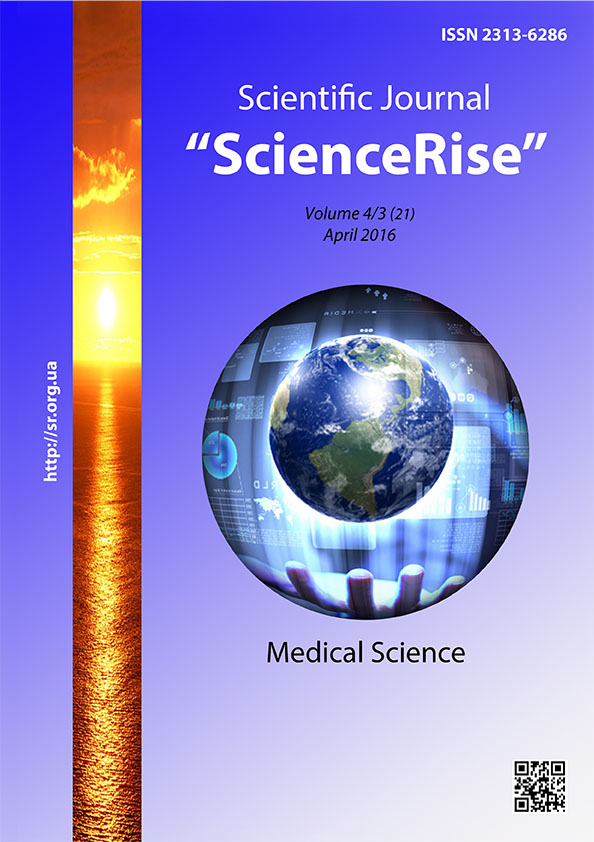About prediction of hearing impairment in infants with extremely low birth weight
DOI:
https://doi.org/10.15587/2313-8416.2016.67694Keywords:
infants with extremely low birth weight, hearing impairment, prediction of the severity of hearing pathologyAbstract
Aim. Evaluation of diagnostic and prognostic informative value of factors that determine the hearing impairment in prematurely born children with extremely low body weight (ELBW) up to the age of three month old.
Methods. Audiological screening of 65 prematurely born infants with ELBW was carried out by the method of induced otoacoustic emission (IOAE) (delayed otoacoustic emission and otoacoustic emission on the distortion product frequency) using the “OtoRid” apparatus (Denmark).
Result. Only 7 newborns (10,8% from all examined) passed the primary screening successfully, 58 children did not pass the test (89,2%), among them 49 children did not pass the test on two ears and 9 children – on the one ear.
Conclusions. Among children with extremely low birth weight the frequency of hearing impairment is 89,2% at the primary examination what is connected with the severity of perinatal pathology at the background of immaturity of the sensor part of hearing apparatus. The audiological screening is necessary for all newborns and especially children with ELBW at birth. Registration of otoacoustic emission by “OtoRid” apparatus is objective, distinct, noninvasive, fast test on detection of defects of sound information perception. Dynamic observation over children with hearing impairment according to the elaborated individual algorithms will favor the development of the unified strategy in the system of catamnestic observation and timely sound reinforcement if necessaryReferences
Antypkin, Yu. H. (2010). Novitni perynatal'ni tekhnolohiyi ta yikh rol' u znyzhenni zakhvoryuvanosti ploda i novonarodzhenykh. Zdorov'e zhenshchyni, 5, 166–170.
Shun'ko, Ye. Ye. (2014). Stratehichni napryamky medychnoyi dopomohy novonarodzhenym v Ukrayini. Neonatolohiya, khirurhiya ta perynatal'na medytsyna, IV, 3 (13), 11–14.
Augustine, A. M., Jana, A. K., Kuruvilla, K. A., Danda, S., Lepcha, A., Ebenezer, J. et. al. (2013). Neonatal hearing screening – Experience from a tertiary care hospital in Southern India. Indian Pediatrics, 51 (3), 179–183. doi: 10.1007/s13312-014-0380-5
Baldwin, M., Watkin, P. (2014). Predicting the Type of Hearing Loss Using Click Auditory Brainstem Response in Babies Referred From Newborn Hearing Screening. Ear and Hearing, 35 (1), 1–9. doi: 10.1097/aud.0b013e31829e0718
Levit, Y., Himmelfarb, M., Dollberg, S. (2015). Sensitivity of the Automated Auditory Brainstem Response in Neonatal Hearing Screening. PEDIATRICS, 136 (3), 641–647. doi: 10.1542/peds.2014-3784
Gargano, G. (2013). Hearing and vision screening. Early Human Development, 89, 5–7. doi: 10.1016/s0378-3782(13)70079-3
Bielecki, I., Horbulewicz, A., Wolan, T. (2011). Risk factors associated with hearing loss in infants: An analysis of 5282 referred neonates. International Journal of Pediatric Otorhinolaryngology, 75 (7), 925–930. doi: 10.1016/j.ijporl.2011.04.007
Driscoll, C., Beswick, R., Doherty, E., D’Silva, R., Cross, A. (2015). The validity of family history as a risk factor in pediatric hearing loss. International Journal of Pediatric Otorhinolaryngology, 79 (5), 654–659. doi: 10.1016/j.ijporl.2015.02.007
Finitzo, T., Albright, K., Neal, J. O. (1998). The Newborn With Hearing Loss: Detection in the Nursery. Pediatrics, 102 (6), 1452–1460. doi: 10.1542/peds.102.6.1452
Mason, J. A., Herrmann, K. R. (1998). Universal Infant Hearing Screening by Automated Auditory Brainstem Response Measurement. Pediatrics, 101 (2), 221–228. doi: 10.1542/peds.101.2.221
Meurer, J., Malloy, M., Kolb, M., Subichin, S., Fleischfresser, S. (2000). Newborn hearing testing at Wisconsin hospitals: a review of the need for universal screening. Europe PubMed Central , 99 (2), 43–46.
Morton, C. C., Nance, W. E. (2006). Newborn Hearing Screening – A Silent Revolution. New England Journal of Medicine, 354 (20), 2151–2164. doi: 10.1056/nejmra050700
Newborn hearing screening program: association between hearing loss and risk factors (2007). Revista de atualizacao cienfifica, 19 (3), 267–278.
Yasinskaya, A. A., Tavartkiladze, G. A. (2008). Ehffektivnost audiologicheskogo skrininga u novorozhdennyh, osnovannogo na ispol'zovanii avtomatizirovannoj registracii zaderzhannoj vyzvannoj otoakusticheskoj ehmissii i stacionarnyh sluhovyh vyzvannyh potencialov. Rossijskaya otorinolaringologiya, Prilozhenie 1, 421–426.
Aryaev, N. L., Kotova, N. V. (2011). Realii i perspektivyi vyihazhivaniya detey s ekstremalno maloy massoy tela pri rozhdenii v mire i Ukraine. NeonatologIya, hIrurgIya ta perinatalna meditsina, I, 101–107.
Wood, N. S., Marlow, N., Costeloe, K., Gibson, A. T., Wilkinson, A. R. (2000). Neurologic and Developmental Disability after Extremely Preterm Birth. New England Journal of Medicine, 343 (6), 378–384. doi: 10.1056/nejm200008103430601
Downloads
Published
Issue
Section
License
Copyright (c) 2016 Ольга Павловна Мельничук, Татьяна Михайловна Клименко

This work is licensed under a Creative Commons Attribution 4.0 International License.
Our journal abides by the Creative Commons CC BY copyright rights and permissions for open access journals.
Authors, who are published in this journal, agree to the following conditions:
1. The authors reserve the right to authorship of the work and pass the first publication right of this work to the journal under the terms of a Creative Commons CC BY, which allows others to freely distribute the published research with the obligatory reference to the authors of the original work and the first publication of the work in this journal.
2. The authors have the right to conclude separate supplement agreements that relate to non-exclusive work distribution in the form in which it has been published by the journal (for example, to upload the work to the online storage of the journal or publish it as part of a monograph), provided that the reference to the first publication of the work in this journal is included.

